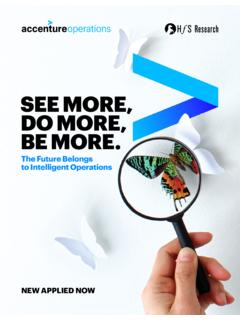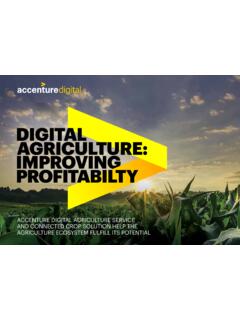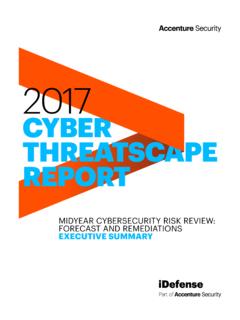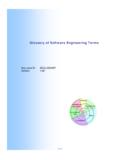Transcription of THE WORLD TODAY IS ALREADY CONNECTED IN WAYS THAT …
1 THE WORLD TODAY IS ALREADY CONNECTED IN WAYS THAT ARE TRULY REVOLUTIONIZING HOW THE HUMAN RACE LIVES, WORKS AND INTERACTS. AND AS TECHNOLOGY EVOLVES, AND AS CARS, PHONES, APPLIANCES, MACHINES AND COUNTLESS OTHER THINGS ACQUIRE A DIGITAL HEARTBEAT AND JOIN THE MORE THAN 3 BILLION DIGITALLY CONNECTED PEOPLE AROUND THE WORLD , THIS REVOLUTION IS SET TO EXPAND EVER FURTHER AND EVER FASTER. 2 | EDGE ANALYTICS PUSHING ADVANCED ANALYTICS TO THE EDGENo industry will be unaffected. As many as 50 billion devices could be CONNECTED to the Internet of Things (IoT) by 2020 according to Cisco, including numerous industrial machines and devices. This will create unprecedented volumes of data and numerous opportunities for growth in the Industrial Internet of Things (IIoT).
2 This is a technology revolution that will fundamentally change how industry operates. But large-scale IIoT deployments have to date been few and far between. The reality is that the IIoT can be a challenge to implement. Enterprises must connect, identify and secure numerous different devices, machines and other things. They must capture, transmit and store data from those things. They must analyze and learn from that data, and integrate it into core operating and information systems. They must train customers, employees and partners in its use. And they must rethink business processes and measures of wonder, then, that many businesses are stuck in the what, how, where phase of their IIoT thinking.
3 But there is a way forward. There is an approach that can quickly generate tangible and measurable value from the IIoT. It s an approach that develops momentum within a business, which can act as a springboard to realizing true enterprise-wide value. It s an approach that means deploying advanced analytics solutions at the edge. 3 | EDGE ANALYTICS PUSHING ADVANCED ANALYTICS TO THE EDGETHE EDGE VS. BIG DATA ANALYTICSBIG DATA ANALYTICSBig data analytics is founded on the principle of the more data the better. It means capturing masses of data and applying sophisticated and advanced technologies, such as machine learning, to unlock the value buried in it. It is suited to situations where the value is unclear, the patterns and outcomes unknown and accuracy is influenced by the amount of data available.
4 But it calls for large numbers of servers and other forms of infrastructure to support the huge volumes of data and the advanced analytics and computing power needed for machine learning to function. The scale of this infrastructure and capability is such that the accepted approach is to provide it in the ANALYTICSA nalytics at the edge is different. It means carrying out the same kind of analysis, but moving more of it to the edge of the network. In other words, closer to the things that are the source of the new data. This could be a car, a washing machine or a fitness device. Or it could be a generator on an oil rig, some agricultural equipment in the field, or any other industrial device.
5 Pushing as much computing workload as close to the edge as possible can bring serious benefits, particularly where communication costs are high or where instant action is needed. But TODAY s edge capabilities are still relatively unsophisticated, lacking anything like the computing power that cloud services can provide. New approaches therefore need to be found. Big data analytics is a well-established concept, enabling organizations to harness huge datasets and derive immediate insights. It lets them make smarter decisions and evolve more efficient operations. And when the IoT really takes off, ever vaster new datasets will become available for ever greater insights. But getting at that data, and transforming it into actionable insights, will bring new challenges.
6 In this context, edge analytics offers something new. How do the two approaches compare?4 | EDGE ANALYTICS PUSHING ADVANCED ANALYTICS TO THE EDGEPUSHING COMPUTATION TO THE EDGE ..In TODAY s IoT, the edge is largely made up of individual sensors with little processing capability a Fitbit fitness device, say that send data to the cloud for computation. While these sensors might connect to a gateway or local edge device that performs some simple analysis as a first-level screening determining how data should be treated, sending an alert if a threshold is breached, etc. the computational heavy lifting is performed in the cloud. 5 | EDGE ANALYTICS PUSHING ADVANCED ANALYTICS TO THE EDGEThe challenge in pushing computation closer to these edge devices is that their capabilities are dictated by their environment.
7 They must, by definition, have a small processing footprint. The answer to this challenge is to design, build and deploy analytical models that address specific problems or objectives. In the process, new value-added capabilities can emerge. Lone Star Analysis (LSA) is a pioneering company working with Accenture to deliver analytics at the edge. The sophisticated computational efficiency of its edge tool, AnalyticsOS, means it can operate complex analytics on a footprint consistent with edge requirements. Advanced predictive and prescriptive analysis can be performed with sufficient granularity to enable meaningful insights to be derived and actions triggered at the edge. A multitude of AnalyticsOS-enabled edge devices can thus work in conjunction with broader cloud-based analytics.
8 Edge analytics could be used to optimize uptime and maintenance for an individual oil well, for example, while cloud-based models optimize across multiple locations at an enterprise | EDGE ANALYTICS PUSHING ADVANCED ANALYTICS TO THE TO DRIVE NEW BUSINESS VALUE Performing sophisticated analysis at the edge means targeted condition- or prediction-based outcomes can be triggered at the level of individual components. And that means the root causes of any problems and their solutions can be identified by an edge analytics model. Consider the example of a $500,000 earth-moving machine. A model could be built that identifies and maps the relationships between the machine s sub-assemblies and model would monitor and analyze data at the component level and would then run simulations to predict the future state of those components.
9 In this way, the model would not only be able to predict a future failure but also the time to that failure at the component, sub-assembly or equipment level. And this can be done to any timescale desired every second, minute or hour as the circumstances | EDGE ANALYTICS PUSHING ADVANCED ANALYTICS TO THE EDGEIMPROVE EQUIPMENT UP TIME AND EFFICIENCYF ailure in a subsystem or component, or the impact of running a component in a degraded state, can be predicted in real time (and continually refined as more data is analyzed) and used to inform operational use and maintenance scheduling. Automated self-correcting actions that continuously optimize performance can also be triggered.
10 REDUCE MAINTENANCE COSTSE quipment failure can be avoided through preventative maintenance undertaken when actually needed, rather than at fixed periods in a predetermined schedule. More repairs can be carried out on first visits by giving mechanics detailed instructions about the causes of a problem, what action is needed, and what parts are ITS SPARES INVENTORYM aintenance crews have an earlier and more precise visibility into future failures and breakdowns, making a spares inventory vastly more analytics models can be tailored to the requirements of an individual device or system. This might mean reading sensors directly associated with certain components and/or subsystems. Or it might mean inferring results based on known and validated calculations.















